Leadership Analysis: Personal Approach and Theories
VerifiedAdded on 2022/12/28
|8
|2189
|1
Essay
AI Summary
This essay provides an analysis of a personal approach to leadership, exploring various frameworks and theories. The author discusses their leadership style, which incorporates elements of authoritarian decision-making, innovative leadership, and transformational leadership. The essay delves into the application of leadership theories, including trait, behavioral, and contingency theories, to motivate workers and develop a workforce. The author highlights the importance of transformational leadership in fostering change and inspiring teams, and the role of different leadership practices in achieving organizational goals. The essay examines the benefits and drawbacks of different leadership styles and concludes that a combination of leadership approaches is essential for adapting to change and fostering teamwork.
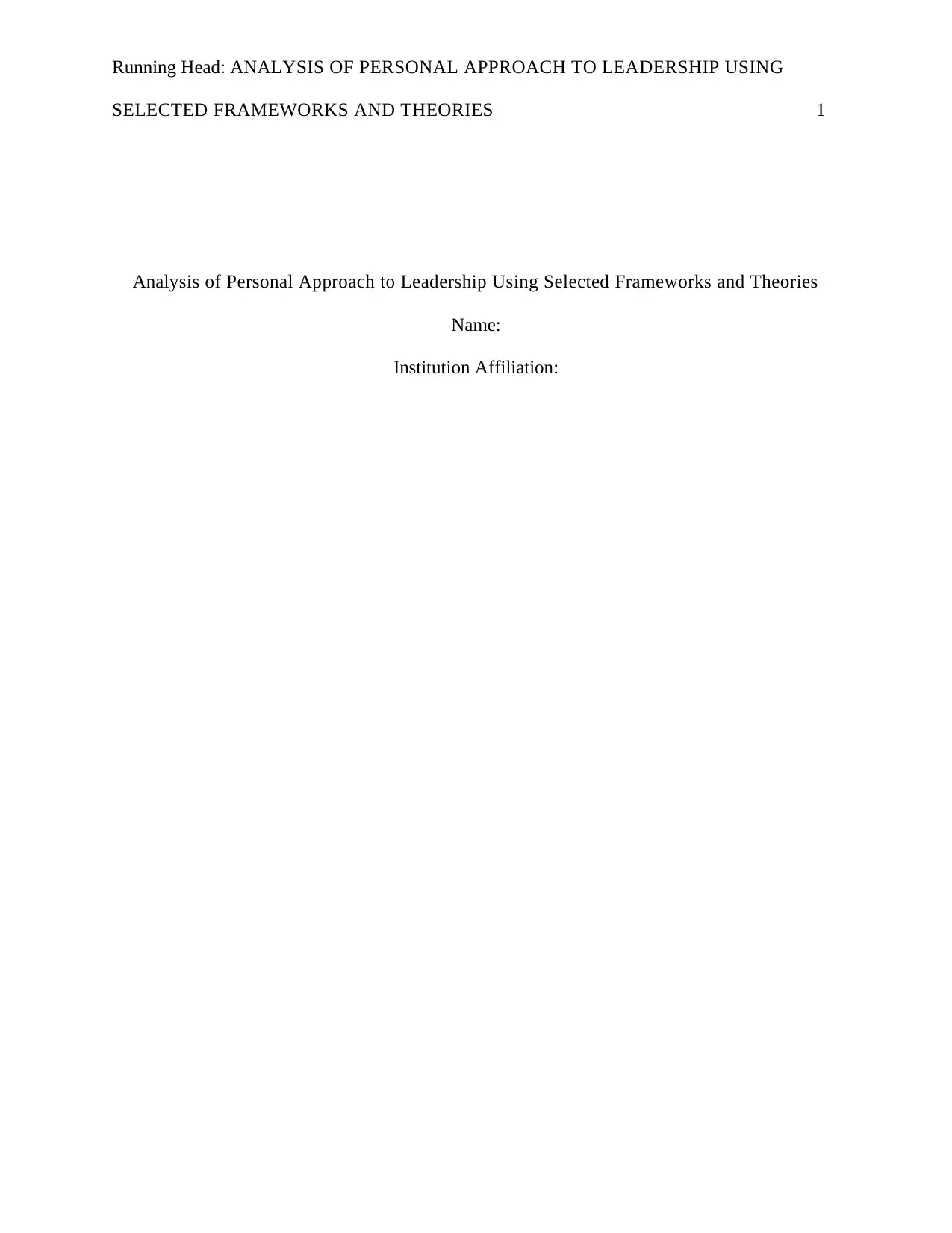
Running Head: ANALYSIS OF PERSONAL APPROACH TO LEADERSHIP USING
SELECTED FRAMEWORKS AND THEORIES 1
Analysis of Personal Approach to Leadership Using Selected Frameworks and Theories
Name:
Institution Affiliation:
SELECTED FRAMEWORKS AND THEORIES 1
Analysis of Personal Approach to Leadership Using Selected Frameworks and Theories
Name:
Institution Affiliation:
Paraphrase This Document
Need a fresh take? Get an instant paraphrase of this document with our AI Paraphraser
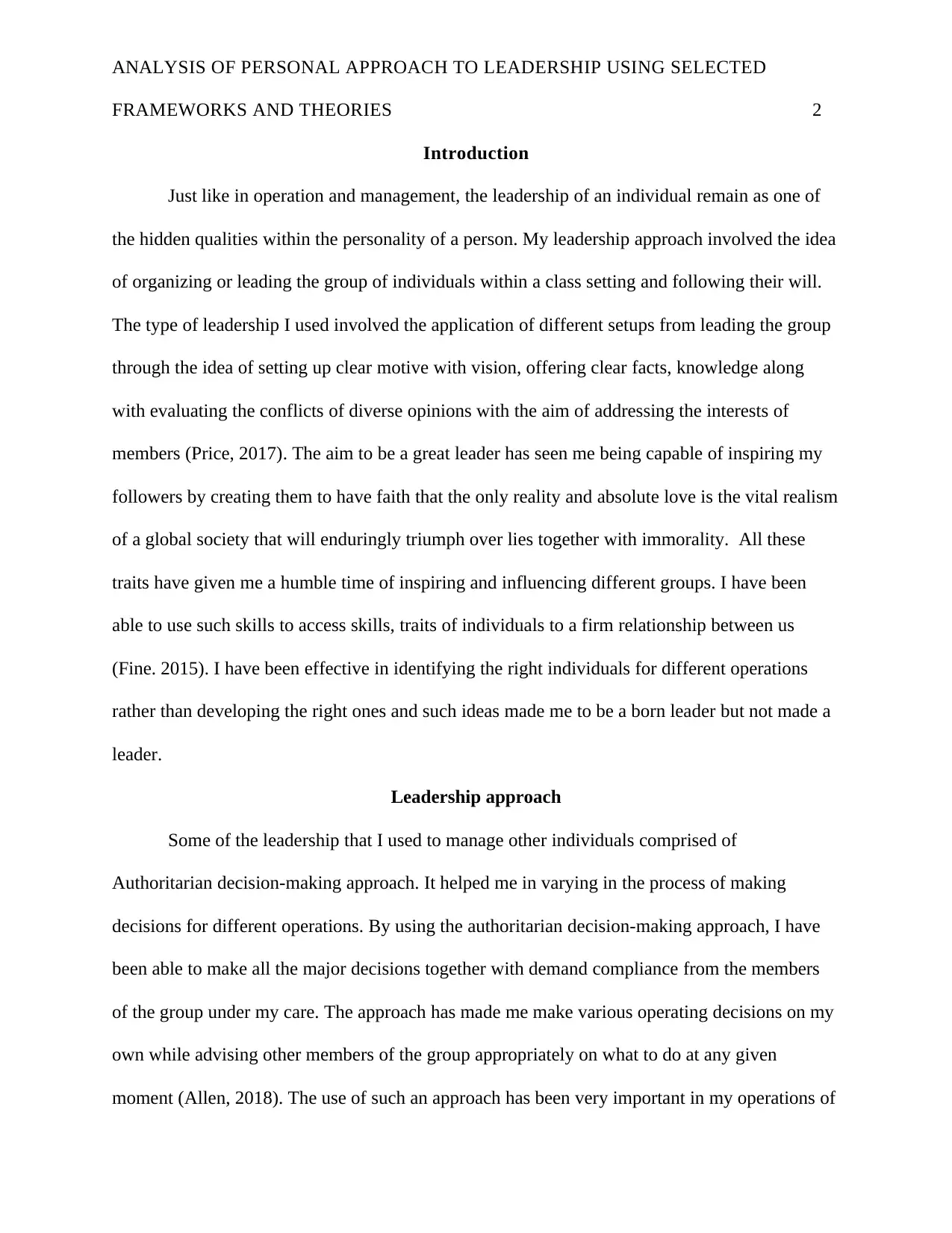
ANALYSIS OF PERSONAL APPROACH TO LEADERSHIP USING SELECTED
FRAMEWORKS AND THEORIES 2
Introduction
Just like in operation and management, the leadership of an individual remain as one of
the hidden qualities within the personality of a person. My leadership approach involved the idea
of organizing or leading the group of individuals within a class setting and following their will.
The type of leadership I used involved the application of different setups from leading the group
through the idea of setting up clear motive with vision, offering clear facts, knowledge along
with evaluating the conflicts of diverse opinions with the aim of addressing the interests of
members (Price, 2017). The aim to be a great leader has seen me being capable of inspiring my
followers by creating them to have faith that the only reality and absolute love is the vital realism
of a global society that will enduringly triumph over lies together with immorality. All these
traits have given me a humble time of inspiring and influencing different groups. I have been
able to use such skills to access skills, traits of individuals to a firm relationship between us
(Fine. 2015). I have been effective in identifying the right individuals for different operations
rather than developing the right ones and such ideas made me to be a born leader but not made a
leader.
Leadership approach
Some of the leadership that I used to manage other individuals comprised of
Authoritarian decision-making approach. It helped me in varying in the process of making
decisions for different operations. By using the authoritarian decision-making approach, I have
been able to make all the major decisions together with demand compliance from the members
of the group under my care. The approach has made me make various operating decisions on my
own while advising other members of the group appropriately on what to do at any given
moment (Allen, 2018). The use of such an approach has been very important in my operations of
FRAMEWORKS AND THEORIES 2
Introduction
Just like in operation and management, the leadership of an individual remain as one of
the hidden qualities within the personality of a person. My leadership approach involved the idea
of organizing or leading the group of individuals within a class setting and following their will.
The type of leadership I used involved the application of different setups from leading the group
through the idea of setting up clear motive with vision, offering clear facts, knowledge along
with evaluating the conflicts of diverse opinions with the aim of addressing the interests of
members (Price, 2017). The aim to be a great leader has seen me being capable of inspiring my
followers by creating them to have faith that the only reality and absolute love is the vital realism
of a global society that will enduringly triumph over lies together with immorality. All these
traits have given me a humble time of inspiring and influencing different groups. I have been
able to use such skills to access skills, traits of individuals to a firm relationship between us
(Fine. 2015). I have been effective in identifying the right individuals for different operations
rather than developing the right ones and such ideas made me to be a born leader but not made a
leader.
Leadership approach
Some of the leadership that I used to manage other individuals comprised of
Authoritarian decision-making approach. It helped me in varying in the process of making
decisions for different operations. By using the authoritarian decision-making approach, I have
been able to make all the major decisions together with demand compliance from the members
of the group under my care. The approach has made me make various operating decisions on my
own while advising other members of the group appropriately on what to do at any given
moment (Allen, 2018). The use of such an approach has been very important in my operations of
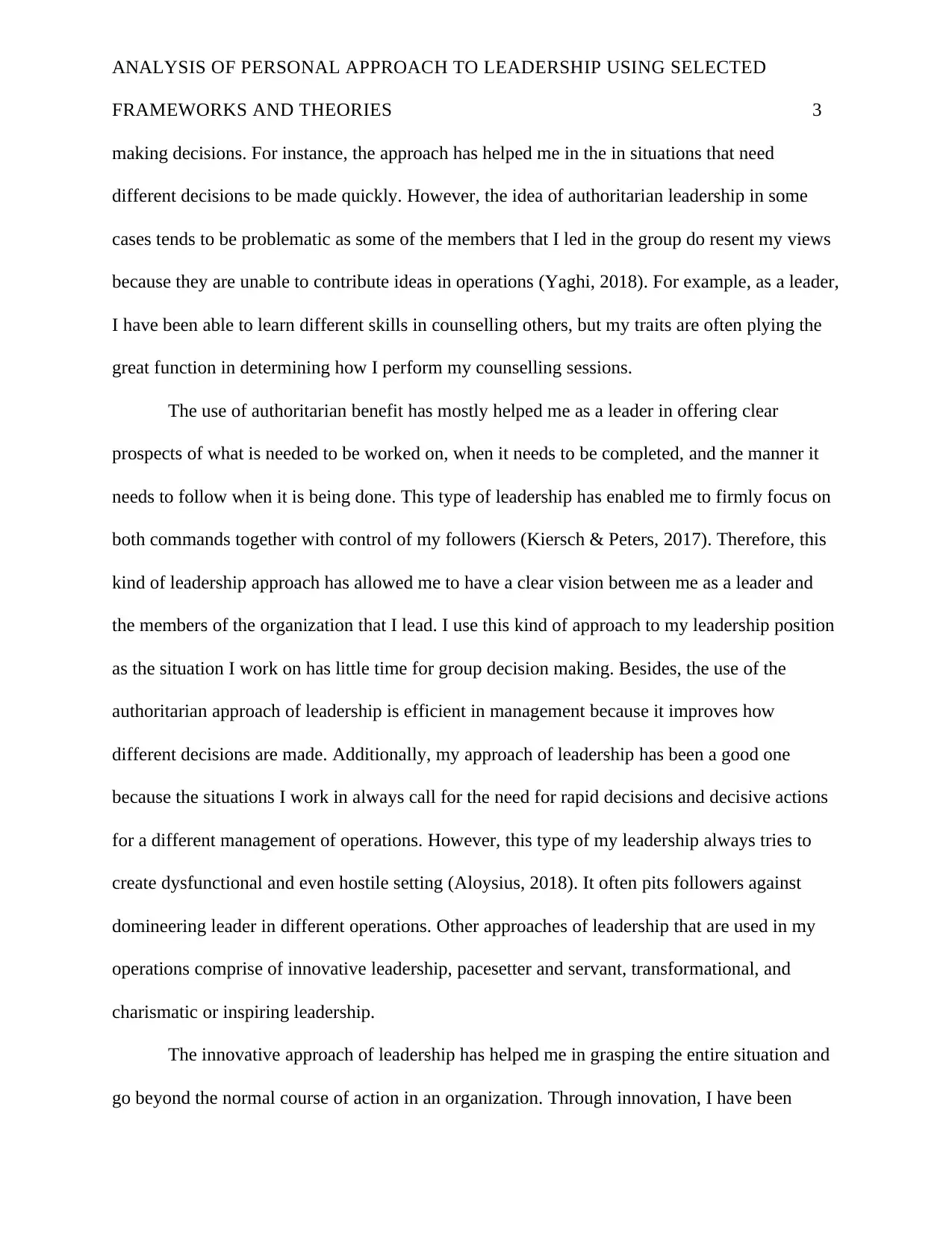
ANALYSIS OF PERSONAL APPROACH TO LEADERSHIP USING SELECTED
FRAMEWORKS AND THEORIES 3
making decisions. For instance, the approach has helped me in the in situations that need
different decisions to be made quickly. However, the idea of authoritarian leadership in some
cases tends to be problematic as some of the members that I led in the group do resent my views
because they are unable to contribute ideas in operations (Yaghi, 2018). For example, as a leader,
I have been able to learn different skills in counselling others, but my traits are often plying the
great function in determining how I perform my counselling sessions.
The use of authoritarian benefit has mostly helped me as a leader in offering clear
prospects of what is needed to be worked on, when it needs to be completed, and the manner it
needs to follow when it is being done. This type of leadership has enabled me to firmly focus on
both commands together with control of my followers (Kiersch & Peters, 2017). Therefore, this
kind of leadership approach has allowed me to have a clear vision between me as a leader and
the members of the organization that I lead. I use this kind of approach to my leadership position
as the situation I work on has little time for group decision making. Besides, the use of the
authoritarian approach of leadership is efficient in management because it improves how
different decisions are made. Additionally, my approach of leadership has been a good one
because the situations I work in always call for the need for rapid decisions and decisive actions
for a different management of operations. However, this type of my leadership always tries to
create dysfunctional and even hostile setting (Aloysius, 2018). It often pits followers against
domineering leader in different operations. Other approaches of leadership that are used in my
operations comprise of innovative leadership, pacesetter and servant, transformational, and
charismatic or inspiring leadership.
The innovative approach of leadership has helped me in grasping the entire situation and
go beyond the normal course of action in an organization. Through innovation, I have been
FRAMEWORKS AND THEORIES 3
making decisions. For instance, the approach has helped me in the in situations that need
different decisions to be made quickly. However, the idea of authoritarian leadership in some
cases tends to be problematic as some of the members that I led in the group do resent my views
because they are unable to contribute ideas in operations (Yaghi, 2018). For example, as a leader,
I have been able to learn different skills in counselling others, but my traits are often plying the
great function in determining how I perform my counselling sessions.
The use of authoritarian benefit has mostly helped me as a leader in offering clear
prospects of what is needed to be worked on, when it needs to be completed, and the manner it
needs to follow when it is being done. This type of leadership has enabled me to firmly focus on
both commands together with control of my followers (Kiersch & Peters, 2017). Therefore, this
kind of leadership approach has allowed me to have a clear vision between me as a leader and
the members of the organization that I lead. I use this kind of approach to my leadership position
as the situation I work on has little time for group decision making. Besides, the use of the
authoritarian approach of leadership is efficient in management because it improves how
different decisions are made. Additionally, my approach of leadership has been a good one
because the situations I work in always call for the need for rapid decisions and decisive actions
for a different management of operations. However, this type of my leadership always tries to
create dysfunctional and even hostile setting (Aloysius, 2018). It often pits followers against
domineering leader in different operations. Other approaches of leadership that are used in my
operations comprise of innovative leadership, pacesetter and servant, transformational, and
charismatic or inspiring leadership.
The innovative approach of leadership has helped me in grasping the entire situation and
go beyond the normal course of action in an organization. Through innovation, I have been
⊘ This is a preview!⊘
Do you want full access?
Subscribe today to unlock all pages.

Trusted by 1+ million students worldwide
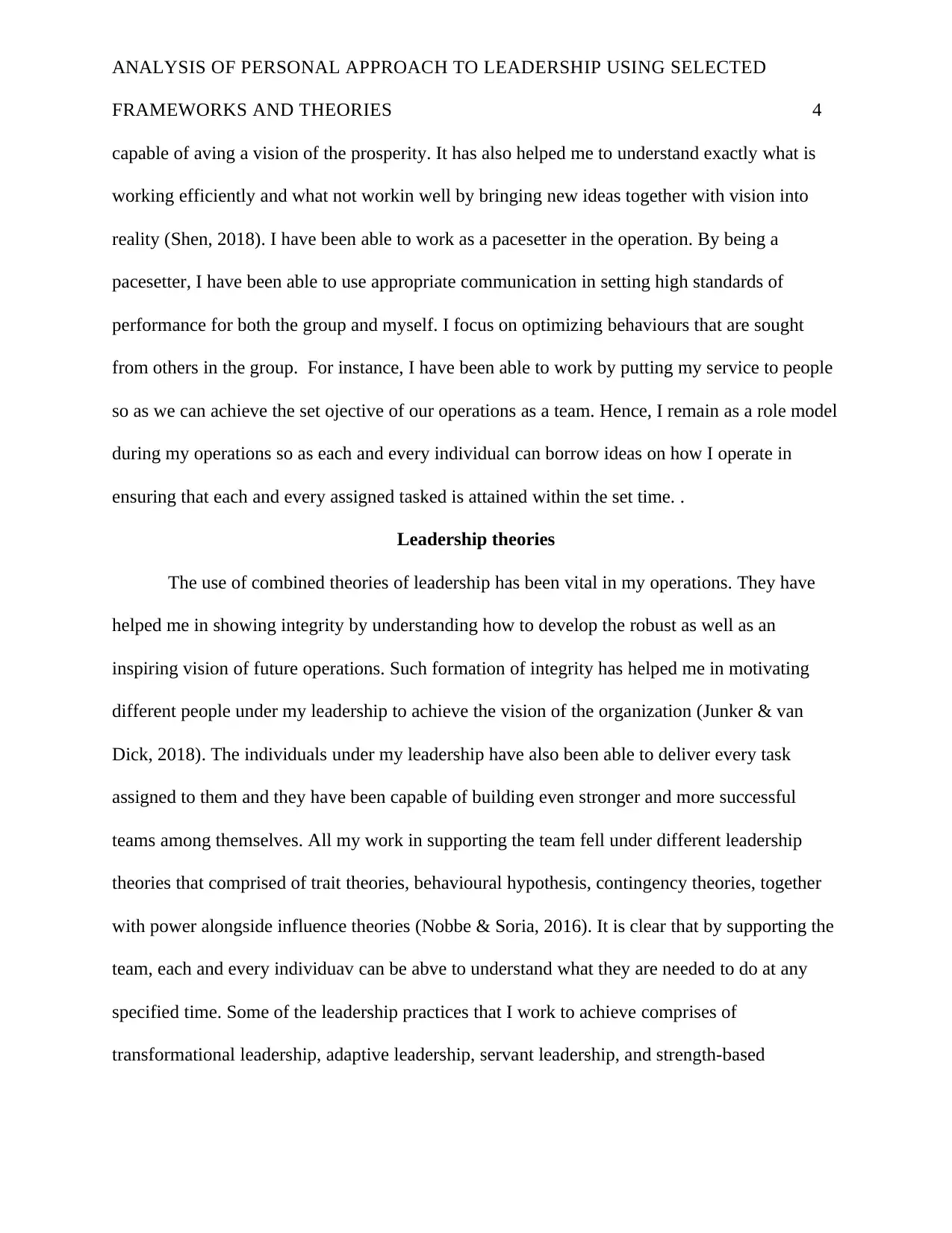
ANALYSIS OF PERSONAL APPROACH TO LEADERSHIP USING SELECTED
FRAMEWORKS AND THEORIES 4
capable of aving a vision of the prosperity. It has also helped me to understand exactly what is
working efficiently and what not workin well by bringing new ideas together with vision into
reality (Shen, 2018). I have been able to work as a pacesetter in the operation. By being a
pacesetter, I have been able to use appropriate communication in setting high standards of
performance for both the group and myself. I focus on optimizing behaviours that are sought
from others in the group. For instance, I have been able to work by putting my service to people
so as we can achieve the set ojective of our operations as a team. Hence, I remain as a role model
during my operations so as each and every individual can borrow ideas on how I operate in
ensuring that each and every assigned tasked is attained within the set time. .
Leadership theories
The use of combined theories of leadership has been vital in my operations. They have
helped me in showing integrity by understanding how to develop the robust as well as an
inspiring vision of future operations. Such formation of integrity has helped me in motivating
different people under my leadership to achieve the vision of the organization (Junker & van
Dick, 2018). The individuals under my leadership have also been able to deliver every task
assigned to them and they have been capable of building even stronger and more successful
teams among themselves. All my work in supporting the team fell under different leadership
theories that comprised of trait theories, behavioural hypothesis, contingency theories, together
with power alongside influence theories (Nobbe & Soria, 2016). It is clear that by supporting the
team, each and every individuav can be abve to understand what they are needed to do at any
specified time. Some of the leadership practices that I work to achieve comprises of
transformational leadership, adaptive leadership, servant leadership, and strength-based
FRAMEWORKS AND THEORIES 4
capable of aving a vision of the prosperity. It has also helped me to understand exactly what is
working efficiently and what not workin well by bringing new ideas together with vision into
reality (Shen, 2018). I have been able to work as a pacesetter in the operation. By being a
pacesetter, I have been able to use appropriate communication in setting high standards of
performance for both the group and myself. I focus on optimizing behaviours that are sought
from others in the group. For instance, I have been able to work by putting my service to people
so as we can achieve the set ojective of our operations as a team. Hence, I remain as a role model
during my operations so as each and every individual can borrow ideas on how I operate in
ensuring that each and every assigned tasked is attained within the set time. .
Leadership theories
The use of combined theories of leadership has been vital in my operations. They have
helped me in showing integrity by understanding how to develop the robust as well as an
inspiring vision of future operations. Such formation of integrity has helped me in motivating
different people under my leadership to achieve the vision of the organization (Junker & van
Dick, 2018). The individuals under my leadership have also been able to deliver every task
assigned to them and they have been capable of building even stronger and more successful
teams among themselves. All my work in supporting the team fell under different leadership
theories that comprised of trait theories, behavioural hypothesis, contingency theories, together
with power alongside influence theories (Nobbe & Soria, 2016). It is clear that by supporting the
team, each and every individuav can be abve to understand what they are needed to do at any
specified time. Some of the leadership practices that I work to achieve comprises of
transformational leadership, adaptive leadership, servant leadership, and strength-based
Paraphrase This Document
Need a fresh take? Get an instant paraphrase of this document with our AI Paraphraser
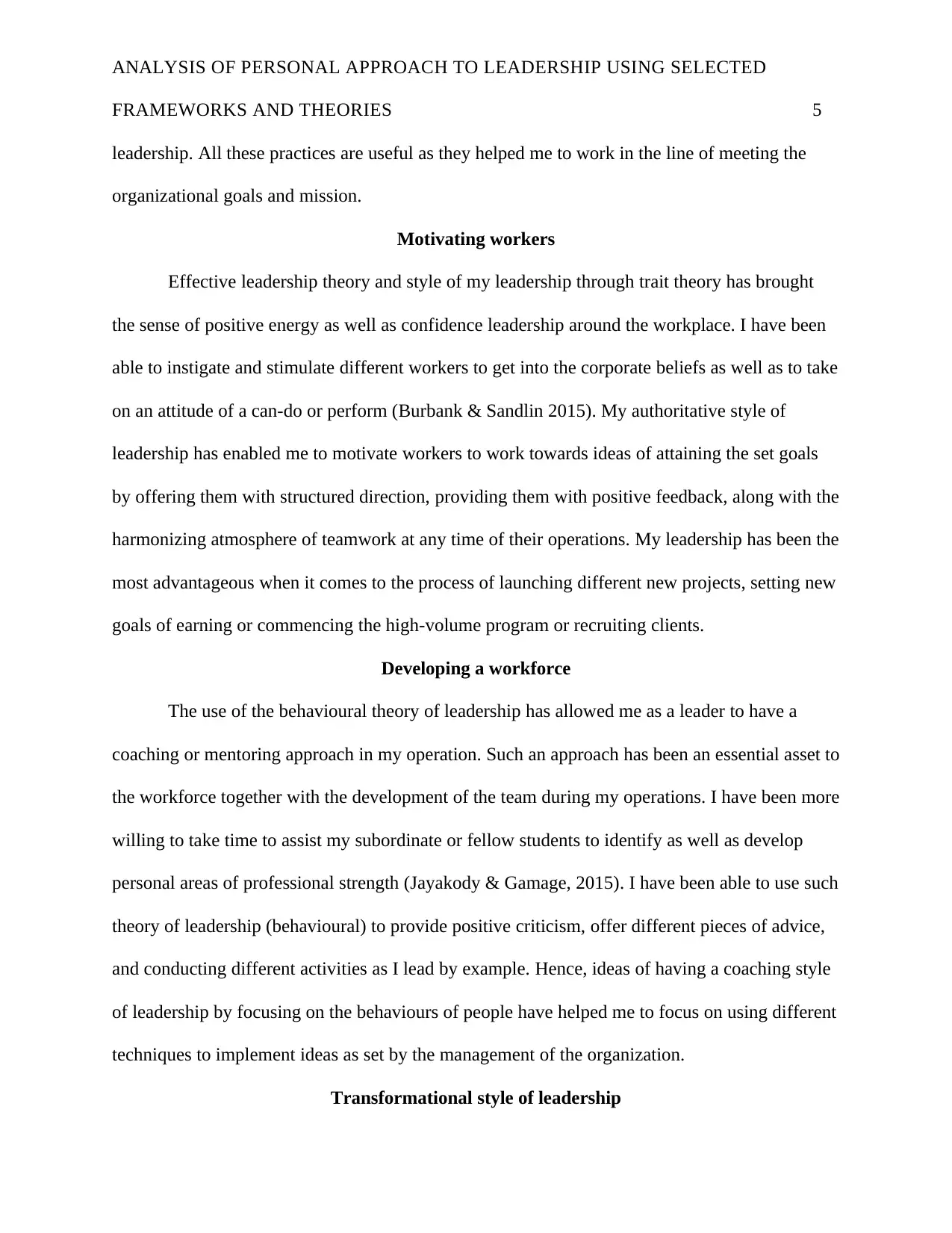
ANALYSIS OF PERSONAL APPROACH TO LEADERSHIP USING SELECTED
FRAMEWORKS AND THEORIES 5
leadership. All these practices are useful as they helped me to work in the line of meeting the
organizational goals and mission.
Motivating workers
Effective leadership theory and style of my leadership through trait theory has brought
the sense of positive energy as well as confidence leadership around the workplace. I have been
able to instigate and stimulate different workers to get into the corporate beliefs as well as to take
on an attitude of a can-do or perform (Burbank & Sandlin 2015). My authoritative style of
leadership has enabled me to motivate workers to work towards ideas of attaining the set goals
by offering them with structured direction, providing them with positive feedback, along with the
harmonizing atmosphere of teamwork at any time of their operations. My leadership has been the
most advantageous when it comes to the process of launching different new projects, setting new
goals of earning or commencing the high-volume program or recruiting clients.
Developing a workforce
The use of the behavioural theory of leadership has allowed me as a leader to have a
coaching or mentoring approach in my operation. Such an approach has been an essential asset to
the workforce together with the development of the team during my operations. I have been more
willing to take time to assist my subordinate or fellow students to identify as well as develop
personal areas of professional strength (Jayakody & Gamage, 2015). I have been able to use such
theory of leadership (behavioural) to provide positive criticism, offer different pieces of advice,
and conducting different activities as I lead by example. Hence, ideas of having a coaching style
of leadership by focusing on the behaviours of people have helped me to focus on using different
techniques to implement ideas as set by the management of the organization.
Transformational style of leadership
FRAMEWORKS AND THEORIES 5
leadership. All these practices are useful as they helped me to work in the line of meeting the
organizational goals and mission.
Motivating workers
Effective leadership theory and style of my leadership through trait theory has brought
the sense of positive energy as well as confidence leadership around the workplace. I have been
able to instigate and stimulate different workers to get into the corporate beliefs as well as to take
on an attitude of a can-do or perform (Burbank & Sandlin 2015). My authoritative style of
leadership has enabled me to motivate workers to work towards ideas of attaining the set goals
by offering them with structured direction, providing them with positive feedback, along with the
harmonizing atmosphere of teamwork at any time of their operations. My leadership has been the
most advantageous when it comes to the process of launching different new projects, setting new
goals of earning or commencing the high-volume program or recruiting clients.
Developing a workforce
The use of the behavioural theory of leadership has allowed me as a leader to have a
coaching or mentoring approach in my operation. Such an approach has been an essential asset to
the workforce together with the development of the team during my operations. I have been more
willing to take time to assist my subordinate or fellow students to identify as well as develop
personal areas of professional strength (Jayakody & Gamage, 2015). I have been able to use such
theory of leadership (behavioural) to provide positive criticism, offer different pieces of advice,
and conducting different activities as I lead by example. Hence, ideas of having a coaching style
of leadership by focusing on the behaviours of people have helped me to focus on using different
techniques to implement ideas as set by the management of the organization.
Transformational style of leadership
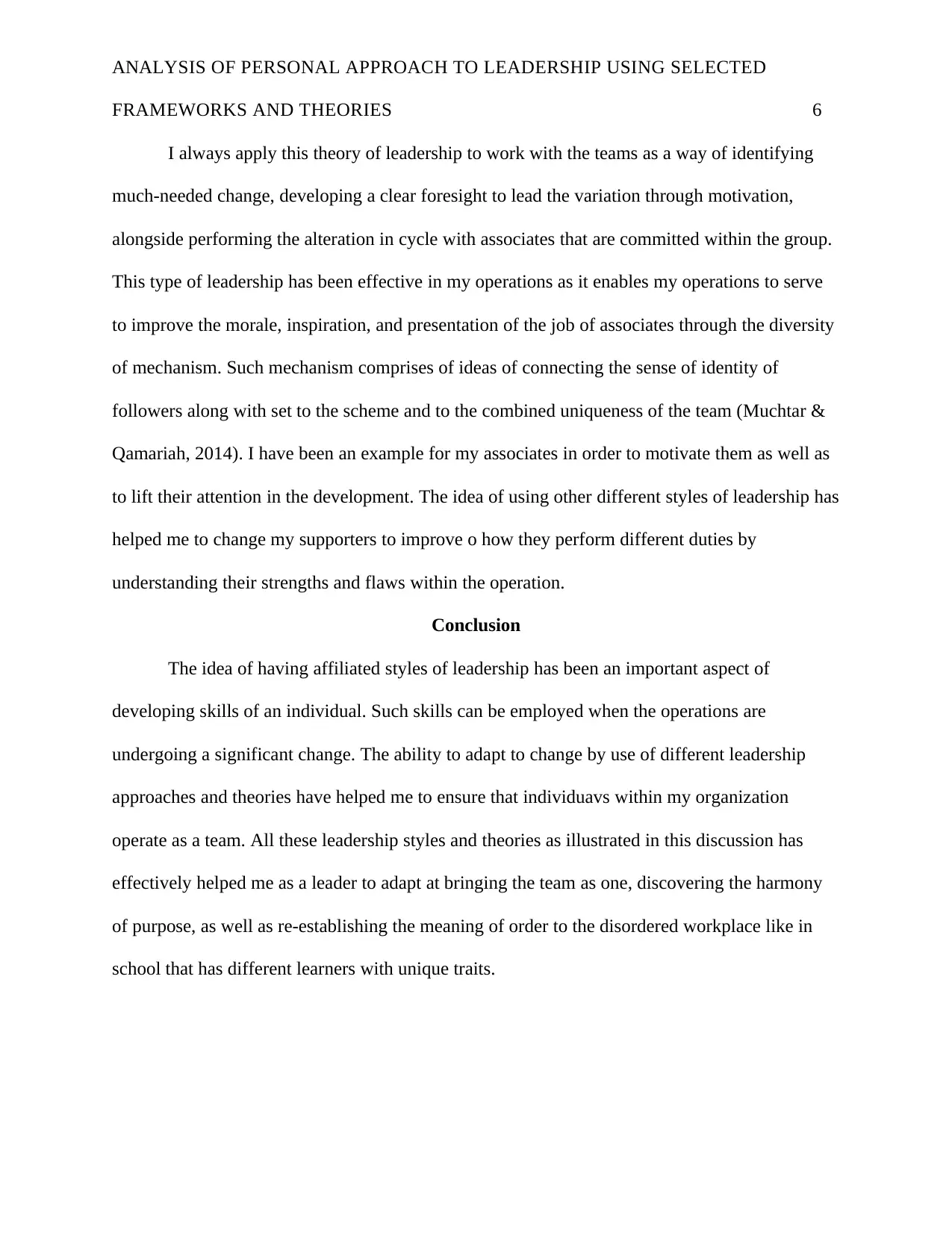
ANALYSIS OF PERSONAL APPROACH TO LEADERSHIP USING SELECTED
FRAMEWORKS AND THEORIES 6
I always apply this theory of leadership to work with the teams as a way of identifying
much-needed change, developing a clear foresight to lead the variation through motivation,
alongside performing the alteration in cycle with associates that are committed within the group.
This type of leadership has been effective in my operations as it enables my operations to serve
to improve the morale, inspiration, and presentation of the job of associates through the diversity
of mechanism. Such mechanism comprises of ideas of connecting the sense of identity of
followers along with set to the scheme and to the combined uniqueness of the team (Muchtar &
Qamariah, 2014). I have been an example for my associates in order to motivate them as well as
to lift their attention in the development. The idea of using other different styles of leadership has
helped me to change my supporters to improve o how they perform different duties by
understanding their strengths and flaws within the operation.
Conclusion
The idea of having affiliated styles of leadership has been an important aspect of
developing skills of an individual. Such skills can be employed when the operations are
undergoing a significant change. The ability to adapt to change by use of different leadership
approaches and theories have helped me to ensure that individuavs within my organization
operate as a team. All these leadership styles and theories as illustrated in this discussion has
effectively helped me as a leader to adapt at bringing the team as one, discovering the harmony
of purpose, as well as re-establishing the meaning of order to the disordered workplace like in
school that has different learners with unique traits.
FRAMEWORKS AND THEORIES 6
I always apply this theory of leadership to work with the teams as a way of identifying
much-needed change, developing a clear foresight to lead the variation through motivation,
alongside performing the alteration in cycle with associates that are committed within the group.
This type of leadership has been effective in my operations as it enables my operations to serve
to improve the morale, inspiration, and presentation of the job of associates through the diversity
of mechanism. Such mechanism comprises of ideas of connecting the sense of identity of
followers along with set to the scheme and to the combined uniqueness of the team (Muchtar &
Qamariah, 2014). I have been an example for my associates in order to motivate them as well as
to lift their attention in the development. The idea of using other different styles of leadership has
helped me to change my supporters to improve o how they perform different duties by
understanding their strengths and flaws within the operation.
Conclusion
The idea of having affiliated styles of leadership has been an important aspect of
developing skills of an individual. Such skills can be employed when the operations are
undergoing a significant change. The ability to adapt to change by use of different leadership
approaches and theories have helped me to ensure that individuavs within my organization
operate as a team. All these leadership styles and theories as illustrated in this discussion has
effectively helped me as a leader to adapt at bringing the team as one, discovering the harmony
of purpose, as well as re-establishing the meaning of order to the disordered workplace like in
school that has different learners with unique traits.
⊘ This is a preview!⊘
Do you want full access?
Subscribe today to unlock all pages.

Trusted by 1+ million students worldwide
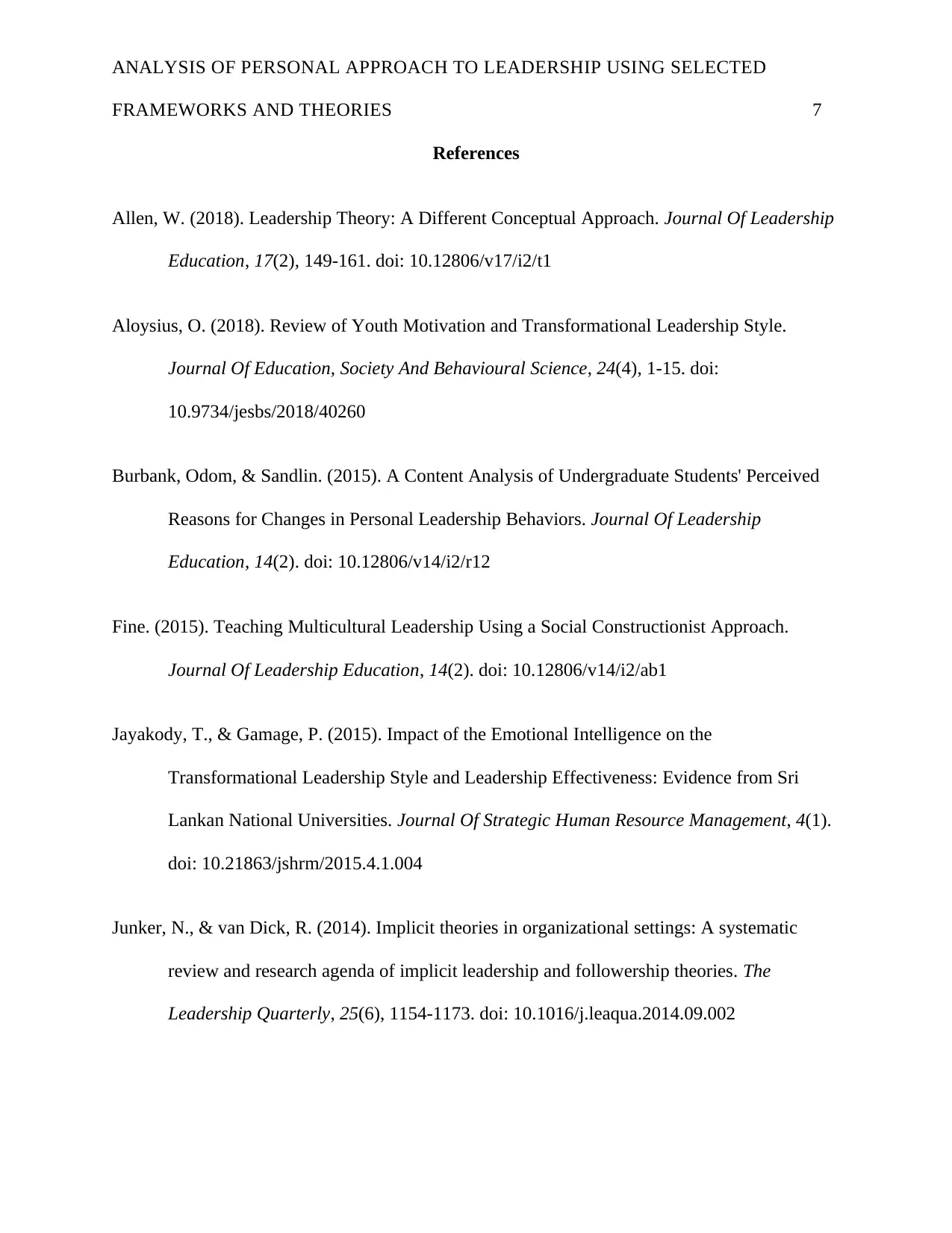
ANALYSIS OF PERSONAL APPROACH TO LEADERSHIP USING SELECTED
FRAMEWORKS AND THEORIES 7
References
Allen, W. (2018). Leadership Theory: A Different Conceptual Approach. Journal Of Leadership
Education, 17(2), 149-161. doi: 10.12806/v17/i2/t1
Aloysius, O. (2018). Review of Youth Motivation and Transformational Leadership Style.
Journal Of Education, Society And Behavioural Science, 24(4), 1-15. doi:
10.9734/jesbs/2018/40260
Burbank, Odom, & Sandlin. (2015). A Content Analysis of Undergraduate Students' Perceived
Reasons for Changes in Personal Leadership Behaviors. Journal Of Leadership
Education, 14(2). doi: 10.12806/v14/i2/r12
Fine. (2015). Teaching Multicultural Leadership Using a Social Constructionist Approach.
Journal Of Leadership Education, 14(2). doi: 10.12806/v14/i2/ab1
Jayakody, T., & Gamage, P. (2015). Impact of the Emotional Intelligence on the
Transformational Leadership Style and Leadership Effectiveness: Evidence from Sri
Lankan National Universities. Journal Of Strategic Human Resource Management, 4(1).
doi: 10.21863/jshrm/2015.4.1.004
Junker, N., & van Dick, R. (2014). Implicit theories in organizational settings: A systematic
review and research agenda of implicit leadership and followership theories. The
Leadership Quarterly, 25(6), 1154-1173. doi: 10.1016/j.leaqua.2014.09.002
FRAMEWORKS AND THEORIES 7
References
Allen, W. (2018). Leadership Theory: A Different Conceptual Approach. Journal Of Leadership
Education, 17(2), 149-161. doi: 10.12806/v17/i2/t1
Aloysius, O. (2018). Review of Youth Motivation and Transformational Leadership Style.
Journal Of Education, Society And Behavioural Science, 24(4), 1-15. doi:
10.9734/jesbs/2018/40260
Burbank, Odom, & Sandlin. (2015). A Content Analysis of Undergraduate Students' Perceived
Reasons for Changes in Personal Leadership Behaviors. Journal Of Leadership
Education, 14(2). doi: 10.12806/v14/i2/r12
Fine. (2015). Teaching Multicultural Leadership Using a Social Constructionist Approach.
Journal Of Leadership Education, 14(2). doi: 10.12806/v14/i2/ab1
Jayakody, T., & Gamage, P. (2015). Impact of the Emotional Intelligence on the
Transformational Leadership Style and Leadership Effectiveness: Evidence from Sri
Lankan National Universities. Journal Of Strategic Human Resource Management, 4(1).
doi: 10.21863/jshrm/2015.4.1.004
Junker, N., & van Dick, R. (2014). Implicit theories in organizational settings: A systematic
review and research agenda of implicit leadership and followership theories. The
Leadership Quarterly, 25(6), 1154-1173. doi: 10.1016/j.leaqua.2014.09.002
Paraphrase This Document
Need a fresh take? Get an instant paraphrase of this document with our AI Paraphraser
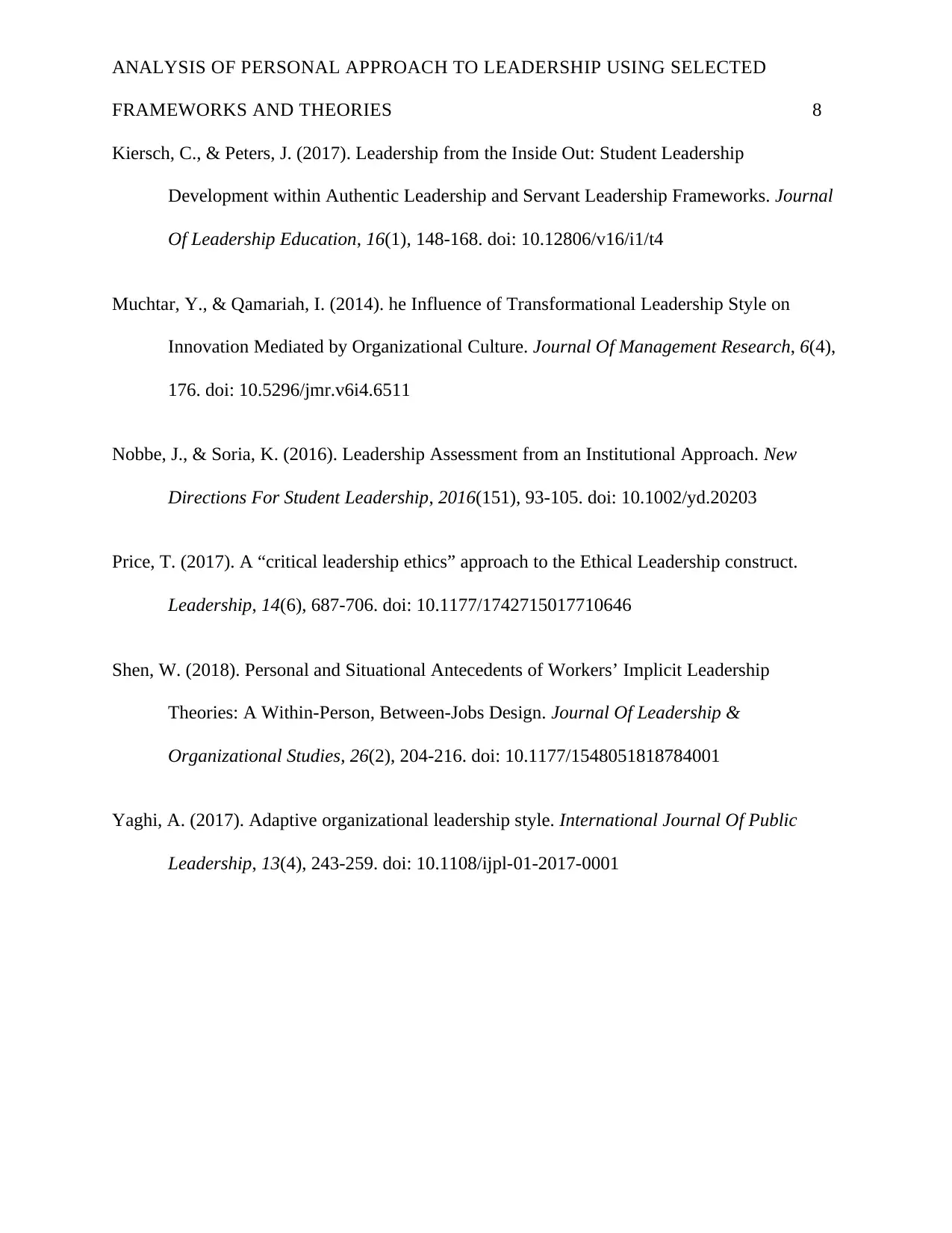
ANALYSIS OF PERSONAL APPROACH TO LEADERSHIP USING SELECTED
FRAMEWORKS AND THEORIES 8
Kiersch, C., & Peters, J. (2017). Leadership from the Inside Out: Student Leadership
Development within Authentic Leadership and Servant Leadership Frameworks. Journal
Of Leadership Education, 16(1), 148-168. doi: 10.12806/v16/i1/t4
Muchtar, Y., & Qamariah, I. (2014). he Influence of Transformational Leadership Style on
Innovation Mediated by Organizational Culture. Journal Of Management Research, 6(4),
176. doi: 10.5296/jmr.v6i4.6511
Nobbe, J., & Soria, K. (2016). Leadership Assessment from an Institutional Approach. New
Directions For Student Leadership, 2016(151), 93-105. doi: 10.1002/yd.20203
Price, T. (2017). A “critical leadership ethics” approach to the Ethical Leadership construct.
Leadership, 14(6), 687-706. doi: 10.1177/1742715017710646
Shen, W. (2018). Personal and Situational Antecedents of Workers’ Implicit Leadership
Theories: A Within-Person, Between-Jobs Design. Journal Of Leadership &
Organizational Studies, 26(2), 204-216. doi: 10.1177/1548051818784001
Yaghi, A. (2017). Adaptive organizational leadership style. International Journal Of Public
Leadership, 13(4), 243-259. doi: 10.1108/ijpl-01-2017-0001
FRAMEWORKS AND THEORIES 8
Kiersch, C., & Peters, J. (2017). Leadership from the Inside Out: Student Leadership
Development within Authentic Leadership and Servant Leadership Frameworks. Journal
Of Leadership Education, 16(1), 148-168. doi: 10.12806/v16/i1/t4
Muchtar, Y., & Qamariah, I. (2014). he Influence of Transformational Leadership Style on
Innovation Mediated by Organizational Culture. Journal Of Management Research, 6(4),
176. doi: 10.5296/jmr.v6i4.6511
Nobbe, J., & Soria, K. (2016). Leadership Assessment from an Institutional Approach. New
Directions For Student Leadership, 2016(151), 93-105. doi: 10.1002/yd.20203
Price, T. (2017). A “critical leadership ethics” approach to the Ethical Leadership construct.
Leadership, 14(6), 687-706. doi: 10.1177/1742715017710646
Shen, W. (2018). Personal and Situational Antecedents of Workers’ Implicit Leadership
Theories: A Within-Person, Between-Jobs Design. Journal Of Leadership &
Organizational Studies, 26(2), 204-216. doi: 10.1177/1548051818784001
Yaghi, A. (2017). Adaptive organizational leadership style. International Journal Of Public
Leadership, 13(4), 243-259. doi: 10.1108/ijpl-01-2017-0001
1 out of 8
Related Documents
Your All-in-One AI-Powered Toolkit for Academic Success.
+13062052269
info@desklib.com
Available 24*7 on WhatsApp / Email
![[object Object]](/_next/static/media/star-bottom.7253800d.svg)
Unlock your academic potential
Copyright © 2020–2025 A2Z Services. All Rights Reserved. Developed and managed by ZUCOL.




